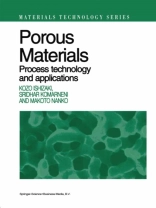Approximately four million years of human history has passed. We have been using materials to make a variety of tools. The first materials used were naturally occurring materials such as animal bones, stones, wood etc.; and some of these familiar materials are porous. Porous materials are so familiar that they are sometimes forgotten or ignored. The taste experience of ice cream is created not only by adjusting ingre- dients, but also by including air as an ingredient, i.e. pores that give the smooth texture of ice cream. This book is designed to describe and explain about pores, the synthesis of materials with pores (porous materials), and applications of porous materi- als. This book is intended for engineers and scientists of different disciplines and specialities, and is expected to be useful in the design and synthesis of porous materials for existing as well as potential new applications. Let us rediscover pores. K. Ishizaki, S. Komameni and M. Nanko January 1998 1 Introduction 1.1 WHAT ARE POROUS MATERIALS? Porous materials are dermed as solids containing pores. Figure 1.1 shows different porous materials. Generally speaking, porous materials have a porosity of 0.2-0.95. The porosity means the fraction of pore volume to the total volume. Porous materials have been used in various applications from daily necessities, such as purifying drinking water by activated carbon or porous ceramics, to uses in modern industries, for example removing dusts from high purity process gases for semiconductor production.
Kozo Ishizaki & Sridhar Komarneni
Porous Materials [PDF ebook]
Process technology and applications
Porous Materials [PDF ebook]
Process technology and applications
Mua cuốn sách điện tử này và nhận thêm 1 cuốn MIỄN PHÍ!
Ngôn ngữ Anh ● định dạng PDF ● ISBN 9781461558118 ● Nhà xuất bản Springer US ● Được phát hành 2013 ● Có thể tải xuống 3 lần ● Tiền tệ EUR ● TÔI 4650372 ● Sao chép bảo vệ Adobe DRM
Yêu cầu trình đọc ebook có khả năng DRM












